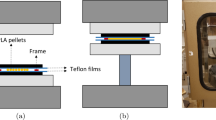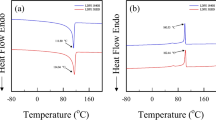Abstract
The split-Hopkinson pressure bar (SHPB) technique has been widely employed for over fifty years in characterizing the high strain-rate properties of many common engineering materials. Historically, however, this technique has had limited success in characterizing soft materials, since their low mechanical impedances can increase delays in attaining dynamic equilibrium and result in transmission pulses with extremely low signal-to-noise ratios. Due to interest in improving characterization of soft materials at high strain rates, numerous modifications to the traditional SHPB technique have been proposed. These include: using more sensitive piezoelectric gauges, employing hollow transmission bars, utilizing lower impedance polymeric pressure bars, and the use of pulse shaping techniques. To date, there has been no comparative studies or consensus within the SHPB community as to which approach is most advantageous. The goal of this investigation is to compare a number of these techniques, specifically the use of PMMA pressure bars and a hollow aluminum transmission bar (both with and without pulse shaping), alongside more traditional solid aluminum pressure bars in the characterization of polyurea, a common low impedance polymer. The advantages and disadvantages of each technique in generating high strain-rate stress-strain curves are discussed.








Similar content being viewed by others
References
Bacon C (1998) An experimental method for considering dispersion and attenuation in a viscoelastic Hopkinson bar. Exp Mech 38(4):242–249
Chen W, Zhang B, Forrestal MJ (1999) A split Hopkinson bar technique for low-impedance materials. Exp Mech 39(2):81–85
Chen W, Lu F, Zhou B (2000) A quartz-crystal-embedded split Hopkinson pressure bar for soft materials. Exp Mech 40(1):1–6
Gama BA, Lopatnikov SL, Gillespie JW Jr (2004) Hopkinson bar experimental technique: a critical review. Appl Mech Rev 57(4):223–250
Doman DA, Cronin DS, Salisbury CP (2006) Characterization of polyurethane rubber at high deformation rates. Exp Mech 46(3):367–376
Duffy J, Campbell JD, Hawley RH (1971) On the use of torsional Hopkinson bar to study rate effects in 1100-0 aluminum. J Appl Mech 38:83–91
Amirkhizi AV, Isaacs J, McGee J, Nemat-Nasser S (2006) An experimentally based viscoelastic constitutive model for polyurea, including pressure and temperature effects. Phil Mag 86(36):5847–5866
Yi J, Boyce MC, Lee GF, Balizer E (2006) Large deformation rate-dependent stress-strain behavior of polyurea and polyrurethanes. Polymer 47(1):319–329
Sarva SS, Deschanel S, Boyce MC, Chen W (2007) Stress-strain behavior of a polyurea and polyurethane from low to high strain rates. Polymer 48(8):2208–2213
Zhao J, Knauss WG, Ravichandran G (2007) Applicability of the time-temperature superposition principle in modeling dynamic response of polyurea. Mech Time-Depend Mater 11(3–4):289–308
Follansbee PS (1985) The Hopkinson bar. Metals handbook, volume 8, mechanical testing, 9th edn. American Society for Metals, Metals Park, pp 198–203
Hopkinson B (1914) A method of measuring the pressure produced in the detonation of high explosives or by the impact of bullets. Philos Trans R Soc Lond Ser A 213:437–456
Zhao H, Gary G (1995) A three dimensional analytical solution of the longitudinal wave propagation in an infinite linear viscoelastic cylindrical bar: application to experimental techniques. J Mech Phys Solids 43(8):1335–1348
Gorham DA, Wu XJ (1997) An empirical method of dispersion correction in the compressive Hopkinson bar test. J Phys IV 7(C3):223–228
Sawas O, Brar NS, Brockman RA (1998) Dynamic characterization of compliant materials using an all-polymeric split Hopkinson bar. Exp Mech 38(3):204–210
Liu Q, Subhash G (2006) Characterization of viscoelastic properties of polymer bar using iterative deconvolution in the time domain. Mech Mater 38(12):1105–1117
Togami TC, Baker WE, Forrestal MJ (1996) A split Hopkinson bar technique to evaluate the performance of accelerometers. J Appl Mech 63:353–356
Davies EDH, Hunter SC (1963) The dynamic compression testing of solids by the method of split Hopkinson pressure bar. J Mech Phys Solids 11(3):155–179
Salisbury CP, Cronin DS (2009) Mechanical properties of ballistic gelatin at high deformation rates. Exp Mech. doi:10.1007/s11340-008-9207-4
Frew DJ, Forrestal MJ, Chen W (2001) A split Hopkinson pressure bar technique to determine compressive stress-strain data for rock materials. Exp Mech 41(1):40–46
Acknowledgements
This work was funded at the Institute for Soldier Nanotechnologies (ISN) by the Army Research Office (ARO), grant DAAD19-02-D-0002, and also through the Joint Improvised Explosive Defeat Organization (JIEDDO), contract number W911NF-07-1-0035.
Author information
Authors and Affiliations
Corresponding author
Rights and permissions
About this article
Cite this article
Johnson, T.P.M., Sarva, S.S. & Socrate, S. Comparison of Low Impedance Split-Hopkinson Pressure Bar Techniques in the Characterization of Polyurea. Exp Mech 50, 931–940 (2010). https://doi.org/10.1007/s11340-009-9305-y
Received:
Accepted:
Published:
Issue Date:
DOI: https://doi.org/10.1007/s11340-009-9305-y




